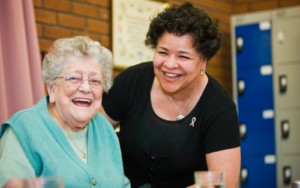Bread or roses? Reframing the role of social work with care homes (Blog 3/3)
Dr Sally Nieman is currently working with My Home Life England through a part-time fellowship with the North Thames Applied Research Collaboration (ARC). This is her final blog in a 3 part series.
 In my previous blogs, I suggested that social workers are not always as visible as they could be in care homes. Their roles often focus on statutory tasks, and this can lead to the perception that they are there to scrutinise and assess, rather than to support. This is not helped by the fact that social work itself can be difficult to define, and is shaped by the paradox between ‘care’ and ‘control’ – supporting people, alongside carrying out responsibilities shaped by the law.
In my previous blogs, I suggested that social workers are not always as visible as they could be in care homes. Their roles often focus on statutory tasks, and this can lead to the perception that they are there to scrutinise and assess, rather than to support. This is not helped by the fact that social work itself can be difficult to define, and is shaped by the paradox between ‘care’ and ‘control’ – supporting people, alongside carrying out responsibilities shaped by the law.
As with care homes, media coverage plays a powerful role in shaping how social workers are seen, influencing public perceptions as well as their own professional identity. Recent research found that negative discourses may undermine social workers, and distract from the real issues facing social care. It also found that public attitudes towards social workers may be more positive than social workers realise. [1]
I recently read an article in the British Medical Journal [2] about the ‘crisis in care’, which referenced the campaigning slogan ‘bread and roses’ used in 1910s America to advocate for workers’ rights. Put simply: bread feeds the body, but roses satisfy the need for sustenance. This made me think that when social workers are restricted to statutory, transactional roles, they are delivering bread – the essentials, the paperwork. But many social workers understand that bread is not enough and they want to bring roses too – which involves building relationships and finding out what matters to people.

Indeed, in my PhD research many social workers spoke about the work they did beyond their statutory roles, which helped them ‘bring the roses’ to older people’s lives. These included practical tasks, like collecting someone’s belongings from their home and bringing them to the care home where they now lived. These actions were profoundly important in supporting transitions to residential care and in finding out what was important to the older person, especially if they did not have family.
 This desire to take a more of a holistic approach where we we seek to understand the lives of older people, and not just fulfil their needs (i.e. deliver them bread), links to My Home Life’s focus on promoting relationship-centred care, using the Senses Framework [3].
This desire to take a more of a holistic approach where we we seek to understand the lives of older people, and not just fulfil their needs (i.e. deliver them bread), links to My Home Life’s focus on promoting relationship-centred care, using the Senses Framework [3].
The Senses Framework outlines six core elements that shape a positive care experience: security, belonging, continuity, purpose, achievement and significance. Considering what might give someone a sense of each of these elements helps to enrich the care that older people receive, and promotes quality of life. These principles apply to the workforce too.
So, how can we rethink the narrative around social workers in care homes, and take a more appreciative lens?
One way may be to look to other models of practice. In hospices in England, social workers play an important role in the multi-disciplinary team to support people holistically at the end of their lives. Could this model benefit care homes too?
Outside of England, other countries, notably the USA, Canada, Israel, Romania, Croatia and Slovenia, employ social workers in care homes, who play a greater role in supporting older people, practically and emotionally, with moving to and living in care homes. The more social workers engage with care homes, the stronger their relationships become, creating a virtuous circle that benefits older people, staff and the wider care system.

Social work itself has a responsibility to play in reframing how it engages with care homes. A stronger focus on ageing in the social work curriculum would help to ensure that working with older people is seen as a valued specialism.
Placements for social work students in care homes could also help to reframe the social work role, so that social workers are not only there at moments of crisis or risk.
Research [4] on inter-professional student training in care homes has highlighted the value of such placements: they helped social work students to develop stronger relationships with care home staff, foster trust and teamwork. They also allowed students to gain deeper understandings of care home environments, increasing their confidence and effectiveness. For this to happen, both the social work profession and care home providers need to see the value of this and test it out.
Structural challenges, resource limitations, and preconceptions might influence the relationship between social workers and care homes. We need to think about how we change the narrative and strengthen connections.
Some practical steps could be:
- Create spaces for connection and partnership working: social workers and care staff need to respect and get to know each other’s roles. What opportunities exist for joint training or reciprocal shadowing, to build trust and relationships?
- Explore opportunities for social work student placements in care homes
- Use frameworks like the Senses Framework to guide staff development and inter-professional collaboration
- Think about how we promote positive stories about care homes and about social work
If we want to adopt an appreciative lens, we need to start by prioritising relationships and seeing the value of social workers and care staff coming together as allies to ensure that older people remain the focus.
A stronger, more intentional social work presence in care homes –with adult-to-adult professional relationships– could break down misconceptions, strengthen partnership working and support better outcomes for the people living in care homes – something we all want to see.
Written by Dr Sally Nieman
If you work in a care home and have thoughts on Sally’s articles, and/or examples of how the relationship between social workers and care homes can work well, we’d love to hear from you.
Get in touch- Joe Hanley, 2025 https://basw.co.uk/policy-and-practice/resources/social-work-public-perception-myth
- https://www.bmj.com/content/380/bmj.p464
- The Senses Framework, Nolan et al. 2006
- https://e-space.mmu.ac.uk/631320/